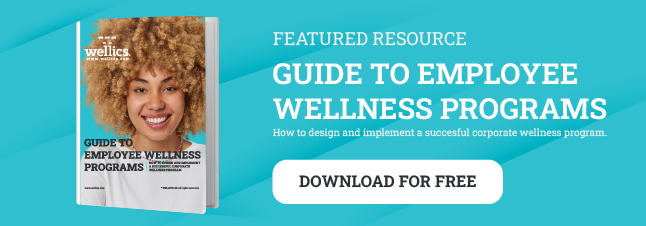Achieving high employee enrollment and participation in corporate wellness programs is critical to the success of workplace health initiatives. To encourage employees to participate, companies can either reward workers for their efforts or penalize them for not meeting certain goals.
Research shows the carrot may be more effective than the stick, with wellness program incentives being more effective than penalties in gaining long-term commitment. Though workplace wellness incentives are critical to high program uptake, the type of incentive you provide matters.
This guide to wellness program incentives provides a breakdown of the different wellness incentive rewards you can offer. We also cover some popular wellness incentive ideas to try with your team.
Benefits of Incentives for Employee Wellness Programs
Employee wellness programs support the core philosophy that healthy employees are happy and productive. Companies adopt wellness programs to help employees change their work and lifestyle habits to achieve optimal performance through better well-being.
Yet the success of a workplace wellness program hinges on the type of incentives employees can expect. The right incentives provide a compelling reason for employees to enroll in their company’s wellness program.
Some of the benefits of effective wellness program incentives include:
- Reward employees fairly for their commitment to health and well-being
- Boost participation rates in corporate wellness programs
- Improve talent recruitment and acquisition
- Promote lifelong healthy habits among employees
Since employers incur significant health-related expenses on behalf of employees, giving workers the tools to take charge of their health can help control these expenses. In addition to cost-reduction, employee wellness incentives also produce more focused, engaged, and productive employees, translating into higher profitability and greater success for the organization.
4 Types of Wellness Program Incentives
When designing your workplace wellness program, it’s essential to consider the different types of incentives you’ll offer. From fitness and health incentives to personal rewards tailored to the employee’s lifestyle, there are plenty of creative perks you can offer employees who commit to their wellness journey.
Below are four types of incentives for wellness program participation.
1. Fitness Incentives
Fitness incentives encourage employees to take their physical fitness to the next level. For office workers who lead predominantly sedentary lifestyles, fitness incentives are particularly beneficial because they encourage more physical activity.
An estimated 47% of American adults don’t meet the CDC guidelines for weekly aerobic activity. Fitness incentives can help foster a culture of increased commitment to aerobic health, curbing inactive behavior.
2. Health Incentives
Traditional health insurance incentive programs provide healthcare expense reimbursement. Today, many wellness programs go beyond basic medical benefits, offering health incentives that promote better daily living, such as rewards for weight loss or going tobacco-free.
Health incentives reward employees who achieve particular health goals, such as adopting a healthy diet for a set period. Some programs also offer perks to workers and their family members for undergoing screenings or health evaluations.
3. Personal Incentives
Wellness isn’t just about a better diet and exercise. It’s also about personal well-being and satisfaction with life. Personal well-being incentives encourage employees to do what’s right for their emotional and mental health too. They’re highly tailored to the unique employee and their needs.
Whether it’s increased vacation time, subsidies for childcare, or support with relocation or upgrading a home office, personal incentives help improve employees’ quality of life.
4. Professional Incentives
Just because employees participate in a wellness program doesn’t necessarily mean they’ll always be incentivized by health-related rewards. For highly engaged employees who are committed to the organization’s goals, one of the best rewards they can receive is something that helps them in their professional development.
Increase wellness program participation among your high-performing employees by offering them rewards that further their careers, such as coaching, education, and other work-related perks.
12 Ideas for Wellness Incentive Rewards
A wellness program is only as successful as the quality of its rewards. Valuable wellness prizes and incentives motivate employees to participate because they genuinely desire the particular reward and want to work toward it.
The following are some popular wellness incentive ideas to offer your employees:
1. Catered lunches or meal delivery — Healthy meal kits and work luncheons
2. Event tickets — Conferences, concerts, festivals, and sporting events
3. Gift cards — Sports stores, vitamin shops, and other health-related retailers
4. Experiences — Ski trips, golf tournaments, and adventure tours
5. Fitness memberships or health coaching — Gym, yoga, or community center passes or personalized health coaching
6. Holistic health services — Massage, chiropractic, and acupuncture sessions
7. Health and wellness gear and equipment — Gym gear, yoga mats, or exercise machines
8. App subscriptions — Meditation, fitness, sleep, or healthy eating premium app subscriptions
9. Cookware and kitchen supplies — Pots and pans, air fryers, or grills to encourage healthy home cooking
10. Home office equipment — Ergonomic chairs, standing desks, or LED desk lighting
11. Healthy home products — Premium mattresses, air quality monitors, or smart home systems
12. Time with leadership and professional retreats — One-on-one time with leadership outside of the workplace to foster motivation, performance, and engagement
Tips for Choosing the Right Wellness Incentives
When choosing a suite of incentives to offer employees for participating in wellness programs, there are some critical factors to keep in mind. The following tips will help you select the right workplace wellness incentives for your team:
- Personalize incentives: It’s important to know your employees and what motivates them personally. The more tailored you can make your incentives to your employees’ actual desires, the more effective the program will be at achieving high enrollment.
- Be specific: The more specific the reward or prize, the more likely it will do its job at incentivizing participation. When employees know exactly what they’re working toward, it maximizes their drive to achieve it.
- Provide variety: Incorporate variety into your wellness program with a combination of smaller wellness activity prizes and higher ticket items for achieving major goals. Having a variety of low, medium, and high-cost incentives, as well as results-based vs. participation-based incentives, allows your program to cater to employees across the board.
- Stay flexible: If you’re implementing a new wellness program, you’ll want to stay open-minded about the types of incentives you offer. Don’t feel you need to commit to a fixed incentive structure. Gauge engagement based on different prizes, and remain flexible so you can iterate your program over time.
Top Employee Wellness Goals to Incentivize
In order for a wellness program to be effective, organizations need to incentivize the right activities that produce targeted outcomes for employee health.
Some of the types of wellness goals that organizations may want to incentivize include:
- Nutrition goals: Nutrition is one of the pillars of physical health. A proper diet, low in sugar and unhealthy fats and high in varied sources of vitamins and nutrients has tremendous preventive health benefits. Incentivizing healthy nutrition and eating habits can help empower employees to take charge of their physical wellness.
- Mental health goals: Employees are a wellspring of creativity, innovation, and productivity provided they're given the right conditions. One of the optimal conditions required to thrive in the workplace is mental health, which encompasses the ability to manage stress and remain focused and engaged. Organizations seeking to support employees with mental health can offer incentives for activities like mindfulness, stress reduction, and other exercises.
- Cardiovascular health goals: One of the major goals of employee wellness programs is to reduce an employee’s lifetime risk of chronic disease, particularly cardiovascular disease. By offering incentives for achieving certain cardiovascular health results, organizations can help employees take charge of their heart health. As a result, employees may see improvements in conditions like hypertension, high cholesterol, and even respiratory conditions, such as asthma.
- Weight management goals: Overweight and obesity are leading contributors to chronic disease, but are also associated with other aspects of well-being, including poor sleep quality and mental health challenges. Incentives that encourage employees to lose weight or maintain their weight can help improve health and well-being across a variety of wellness dimensions.
- Exercise goals: Physical activity has extensive health benefits. Not only does regular exercise reduce the risk of cardiovascular disease, but it’s also a known mood enhancer and can stave off cognitive decline. Getting adequate exercise also leads to improved sleep quality and creates positive momentum for building other healthy lifestyle habits. Incentivizing activity goals is one of the simplest ways to support employees in improving their total wellness profile.
Prioritizing Wellness Outcomes With Incentives
Incentives are designed to drive employees to adopt habits that over time lead to specific health outcomes. Which health outcomes are most desirable depends on the employee and their current health status and level of lifestyle habits. For employees with high cardiovascular disease risk profiles, exercise, nutrition, and smoking cessation are priority outcomes. For employees with mental health challenges, stress management and sleep may be the most important wellness factors to focus on.
In order to produce optimal outcomes, wellness program managers must take an intelligent approach to incentivizing employee health habits. A large part of finding the right approach is knowing how to prioritize certain wellness goals using incentive structures.
Below are some steps to take when prioritizing wellness outcomes with incentives:
1. Establish an internal wellness committee: An internal wellness committee is tasked with determining the main organizational wellness goals. A wellness committee can be composed of employees, managers, and health experts who all provide input on how to incentivize the behaviors that lead to selected health outcomes.
2. Select priority wellness outcomes: Using data collected from employee health risk assessments, committee leaders can determine which areas of health present the largest opportunity for improvement. Create a list of target behaviors you want to encourage, activities you want to promote, or health risks you want to prevent through your employee wellness program.
3. Create an incentive hierarchy: Assign the most valuable incentives to the highest priority wellness outcomes. For example, if smoking cessation is a major priority for your organization, then offer the largest and most robust incentive to quit smoking in order to drive outcomes in this wellness area.
4. Adapt incentives: Be flexible as health outcomes are achieved. Have an internal system, like a wellness platform, that allows for your wellness committee to continuously review how effective your incentives are and how to adjust them as employees reach certain goals or milestones.
FAQs About Employee Wellness Program Incentives
Organizations starting new employee wellness programs often have many questions about how incentive programs work and whether they’re worth the investment. Below are some of the top FAQs about employee wellness program incentives.
1. How Do I Verify Employee Completion of Incentivized Activities?
An important part of an effective employee wellness incentive program is having the ability to validate or verify that employees have completed or achieved the activity or set of behaviors they are incentivized to pursue. Verifying employee activity ensures accuracy and allows for organizations to administer incentives that actually reward positive change and build momentum toward lasting improvements.
The ability to verify whether an employee has completed an activity depends on the type of activity. With most wellness platforms, verification happens through a combination of biometric screening, fitness device data, and self-reporting. Make sure that you choose activities that are verifiable when deciding which types of outcomes you want to incentivize.
2. Are Wellness Incentives Compliant With Privacy Laws?
Most jurisdictions today have strict health privacy laws that prevent employers or other parties from accessing private health information. The Health Insurance Portability and Accountability Act of 1996 (HIPAA) guarantees the rights of U.S. employees to keep their personal health information private from employers.
However, employee wellness programs are designed to be voluntary. Employees can choose whether they want to enroll in the program and can adjust the degree to which they participate, meaning that wellness incentive structures are legal provided the employee knowingly consents.
Watch the 2'12" video below to learn more about employee medical privacy rights under HIPAA.
3. Are Wellness Incentives Considered Taxable Earnings?
Wellness incentives, such as cash rewards or reimbursements for health-related products and services, may be considered taxable earnings, depending on the country. In the U.S., the IRS does require employers to withhold federal tax on wellness incentives.
Alternatively, employers can set up tax-free Health Savings Accounts (HSAs) for employees, and deposit cash rewards and reimbursements directly into these accounts so that employees don’t have a portion of their incentives withheld for income tax.
4. What’s the ROI on Wellness Incentives?
Employee wellness programs can be highly effective at fostering health behavior change among employees. This leads to reduced organizational costs like:
- Absenteeism and presenteeism costs
- Employee turnover rates
- Health care expenditures
In order for organizations to get the maximum return on their employee wellness investment, the program and the incentives need to be strategically planned and properly executed. Organizations need to continuously revisit and adjust their programs and incentive structures to ensure maximum effectiveness in promoting healthy behavior change.
Learn more about how to calculate the ROI on employee wellness programs.
Maximizing Employee Wellness Programs
Choosing the right wellness challenge prizes and incentives is key to maximizing your employee wellness program. From health and well-being rewards to prizes that improve your employees’ work-life balance, there are plenty of ways to incentivize employee enrollment in your corporate wellness program. By understanding your employees’ motivations, goals, and lifestyle needs, you can select the optimal incentives that will produce the desired results.
Get the most from your employee wellness program by using the powerful Wellics platform. With Wellics, your organization can inspire, motivate, educate, and reward employees all in one platform. Monitor your employees' rewards from the admin account. By tracking your top performers and achievers, you'll gain insight into how your employees respond to certain rewards, allowing you to adjust your wellness incentive programs accordingly.
Learn how our workplace wellness software can help your organization maximize your ROI on employee wellness programs and incentives using our comprehensive analytics tools. Explore the benefits of the Wellics employee wellness program today.
Originally published March 21, 2022 - 13:09 PM, updated September 3, 2024
Sources
- https://www.nejm.org/doi/full/10.1056/nejmoa1414293
- https://www.shrm.org/
- https://www.cdc.gov/nchs/fastats/exercise.htm
- https://www.hsph.harvard.edu/nutritionsource/sleep/
- https://www.ncoa.org/article/how-excess-weight-impacts-our-mental-and-emotional-health
- https://www.hopkinsmedicine.org/health/wellness-and-prevention/exercise-and-the-heart
- https://www.apa.org/monitor/2011/12/exercise
- https://www.hopkinsmedicine.org/health/wellness-and-prevention/exercising-for-better-sleep
- https://bmjopensem.bmj.com/content/5/1/e000500
- https://www.youtube.com/watch?v=FKTHncn-5Vs&list=PLACD9536723837201










